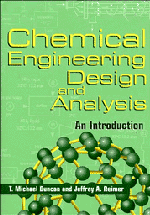Book contents
- Frontmatter
- Contents
- Preface
- Acknowledgments
- 1 An Overview of Chemical Engineering
- 2 Process Design
- 3 Models Derived from Laws and Mathematical Analysis
- 4 Graphical Analysis
- 5 Dimensional Analysis and Dynamic Scaling
- 6 Transient Processes
- Appendix A List of Symbols
- Appendix B Units, Conversion Factors, and Physical Constants
- Appendix C Significant Figures
- Appendix D Graph Paper
- Appendix E Mathematics, Mechanics, and Thermodynamics
- Appendix F Glossary of Chemical Engineering
- Index
6 - Transient Processes
- Frontmatter
- Contents
- Preface
- Acknowledgments
- 1 An Overview of Chemical Engineering
- 2 Process Design
- 3 Models Derived from Laws and Mathematical Analysis
- 4 Graphical Analysis
- 5 Dimensional Analysis and Dynamic Scaling
- 6 Transient Processes
- Appendix A List of Symbols
- Appendix B Units, Conversion Factors, and Physical Constants
- Appendix C Significant Figures
- Appendix D Graph Paper
- Appendix E Mathematics, Mechanics, and Thermodynamics
- Appendix F Glossary of Chemical Engineering
- Index
Summary
IN CHAPTER 3 WE ANALYZED PROCESSES by developing models based on fundamental laws, such as conservation principles. We restricted our analyses to systems at steady state, namely where none of the variables changed with time. This simplified the mathematical modeling since we dealt only with algebraic equations; such models, as we saw, are extremely useful for analyzing steady-state systems.
Many chemical processes, however, do not operate at steady state. A chemical reaction performed one batch at a time, such as the experiments you have done in your secondary school and first-year chemistry classes, is an example of an unsteady process. Thus we need design tools for processes that are inherently time dependent. Furthermore, even when designing a steady-state process, time-dependent problems occur: For example, how does one start one of the elegant processes we designed in Chapter 2? A member of the faculty at a leading U.S. university tells an interesting anecdote. When he was a design engineer employed at a major oil company he designed a continuous reactor that was constructed but could not be started. Furthermore, this happened twice! The hard-earned lesson is that a thorough understanding of transients is required to start, stop, and control a continuous process.
A nonsteady process, or transient process, is one where at least one of the process variables changes with time. Modeling a transient process usually involves a differential equation.
Information
- Type
- Chapter
- Information
- Chemical Engineering Design and AnalysisAn Introduction, pp. 310 - 350Publisher: Cambridge University PressPrint publication year: 1998
